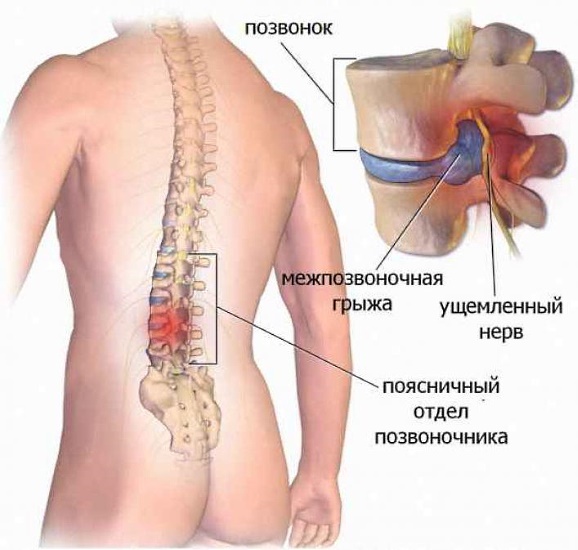The technique of performing exercises during sports not only determines the effectiveness of training and the speed of achieving the goal set by the athlete, but also, if it is observed, reduces the risk of injury to a person.
The gluteal bridge, being one of the most effective loads for lower body work, also requires strict adherence to generally accepted techniques. Otherwise, an incorrectly distributed load can provoke the formation of hernias, protrusions in the spine, and also cause sprains, tears of muscles, tendons or ligaments.
What is the gluteal bridge, which muscles work
The gluteal bridge, the technique of which implies not only control over the position of all parts of the athlete's body, but also his breathing during exercise, is lifting the pelvis from a lying position on the floor or sitting in the simulator.
You can perform the bridge both with your own weight and using additional weights. Fitness trainers recommend including pelvic lifts in the middle or at the end of the training complex, since one of its main positive effects on the human body is stretching the muscles of the lower body.
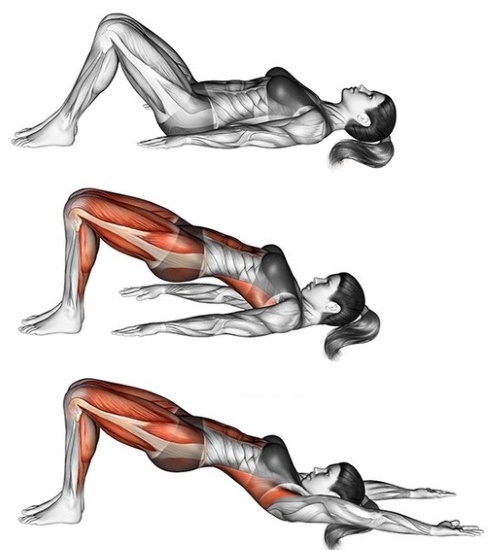
| Muscle group category | Names of specific muscle groups |
| Main (they account for most of the load) | Subject to the technique of performing the bridge, the load is mainly distributed between:
|
| Additional (muscles that involve secondary) | Subject to the technique of performing the bridge, a small percentage of the load is also distributed between:
|
Benefits of the gluteal bridge for building gluteal volume and strength
The positive aspects of the impact of the gluteal bridge on the athlete's body (provided that the exercise is performed correctly) include:
- improvement of blood circulation in the pelvic organs;
- reduction of pain during menstruation;
- even distribution of the load on the lower body (including the lower spine);
- an increase in strength indicators that have a positive effect on leg endurance during prolonged walking or intense running;
- stabilization of the muscles of the central part of the back;
- prevention of pain in the lower back or lower thoracic spine;
- building muscle in the buttocks and thighs;
- improving the mobility of the joints of the lower body (necessary to prevent the occurrence of arthrosis or arthritis, usually occurring as the athlete's body ages).
Contraindications
The gluteal bridge, the technique of which must be explained to the athlete by a fitness trainer, can be dangerous to a person's health.
The main contraindications for performing this exercise include:
- exacerbation of chronic diseases;
- acute inflammatory processes in the body, accompanied by an increase in the athlete's body temperature;
- thrombosis;
- thrombophlebitis;
- recent surgical interventions (less than 6 months have passed since the operation);
- recent injuries, especially of the spine or lower extremities (from the moment of complete recovery of the athlete after injury, at least 3-4 months should pass);
- hernia in the lumbar spine;
- profuse menstruation (additional stimulation of blood flow in the small pelvis can provoke the opening of uterine bleeding);
- pregnancy;
- benign or malignant neoplasms in the pelvic area (stimulation of lymph flow and blood flow can lead to a rapid growth of a neoplasm or its transition from benign to malignant);
- tendency to hemophilia.
Glute bridge options. Technique for women
Given that the glute bridge is included in the training program for almost all athletes, fitness trainers regularly develop new variations of this exercise. Otherwise, the muscles adapt to the load, which will lead to a decrease in the effectiveness of the training.
Classic no weights on the floor
The classic technique for performing a gluteal bridge without weights from a position lying on the floor looks like this:
- Lie on the floor, on your back. Direct your gaze to the ceiling, put your hands along the body, bend your legs at the knees, placing your feet at a distance of 20-30 cm from each other. In the starting position, the stomach should be drawn in, and the lower back should be pressed as much as possible to the floor.
- With an exhalation, it is necessary to tear the buttocks off the floor, lifting the hips as high as possible. The body weight at the time of the change in position should be distributed between the feet and the upper back, which remains on the floor. When the buttocks are at the highest point, the hips should be kept parallel to each other. Knee pinching can shift the load and increase the risk of joint injury.
- Hold at the top point for 5 seconds, after which, slowly inhaling, lower the hips to the supporting surface.
To complicate the exercise, when returning to the original position, it is recommended not to lower the hips to the end, holding them at a point 5-7 cm from the floor. Beginner athletes should perform 3-4 sets of 10-25 repetitions, depending on physical fitness and the presence of contraindications in a particular person.
With tape, elastic band
The glute bridge, the technique of which involves the use of an elastic tape or elastic band, is recommended for athletes whose muscles have already adapted to the load provided by the classic version of this exercise. The optimal number of repetitions in this case will be 3-4 sets of 10-15 repetitions.
The algorithm for correct execution of the load looks like this:
- Lie on the floor with your back down. Put your hands behind your head or place them along the body. The legs should be bent at the knees, after passing them through elastic bands. The elastic bands should be placed on the hips, 4-5 cm above the knee joints. To properly stretch the spine, the head must be turned face up.
- Making a powerful exhalation, the buttocks must be torn off the support surface, lifting them until a straight line forms in the body.
- Pause at the peak point of muscle tension for at least 3-5 seconds, after which, inhaling through the nose, lower the hips to the starting position.
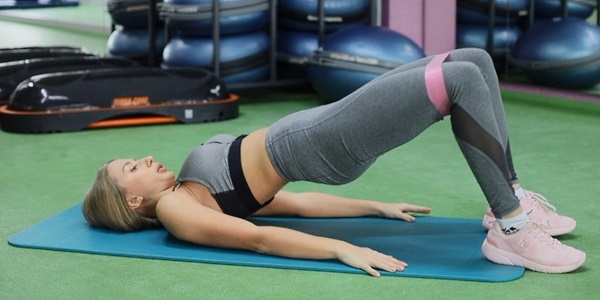
With pressed, knees
The glute bridge with knee bridging or knee bridging can be done in several ways, with or without elastic band.The optimal number of repetitions is 3-4 sets of 15-18 times, depending on the physical fitness of the athlete. Breathing should be done in a classical way - inhaling through the nose, exhaling through the mouth.
The technique for performing the exercise looks like this:
- Lie on the floor with your back down. Hands must be placed along the body, look to the ceiling, press in the back against the supporting surface. The legs must be bent at the knees, placing the feet at shoulder distance.
- Simultaneously with the exhalation, the buttocks must be torn off the floor, pushing the thighs with the muscles as high as possible above the supporting surface. At the moment of reaching peak tension, the knees should be brought together and then immediately returned to their original position.
- Lower the buttocks to their original position.
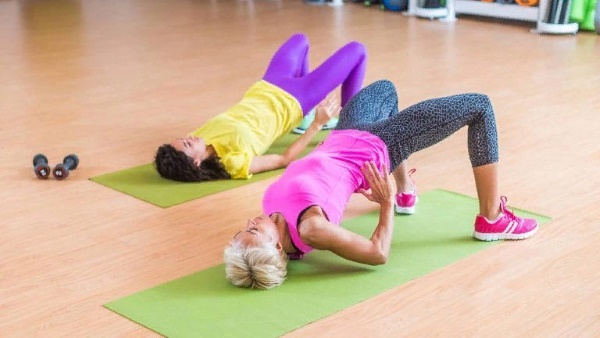
The most difficult version of the exercise is the one in which the raising and lowering of the pelvis occurs only once - at the beginning and at the end of the exercise. While the hips are at the top, the athlete must perform springy movements, bringing the knees together and apart for 40-60 seconds.
On one supporting leg
The gluteal bridge, the technique of which is considered one of the most difficult, involves finding the athlete while practicing the exercise in a standing position on one leg. The optimal number of repetitions in this case is 15-20 times, performed in 2-3 sets, for each leg.
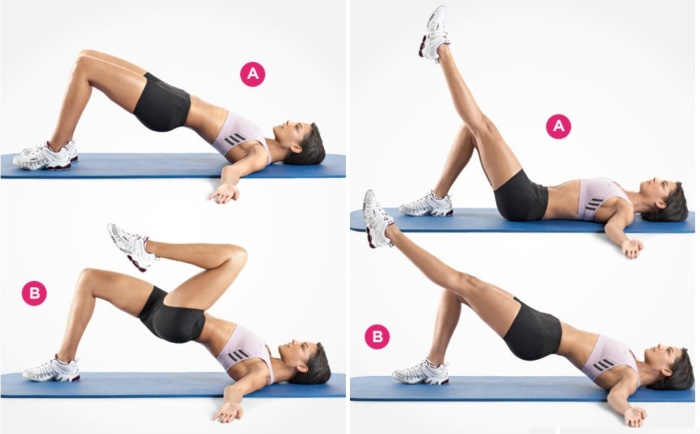
- Lie on the floor with your back down. Put your hands along the body or put them behind your head. The stomach needs to be drawn in, the back is pressed as much as possible to the supporting surface. The legs must be bent at the knees, placing the feet at a distance of 20-30 cm from each other. Put one of the legs on the other, in the area above the kneecap.
- As you exhale, raise your buttocks as far as possible from the floor. Feeling strong muscle tension, you need to pause for 2-3 seconds, then return to its original position.
- After completing the required number of repetitions, the legs should be swapped, placing the limb that was supporting on the other leg.
On fitball
A gluteal bridge, performed with a fitball, not only strains the muscles of the lower body, but also promotes the development of coordination of movements, and also provides additional stress on the abdominal muscles due to the need to maintain balance.
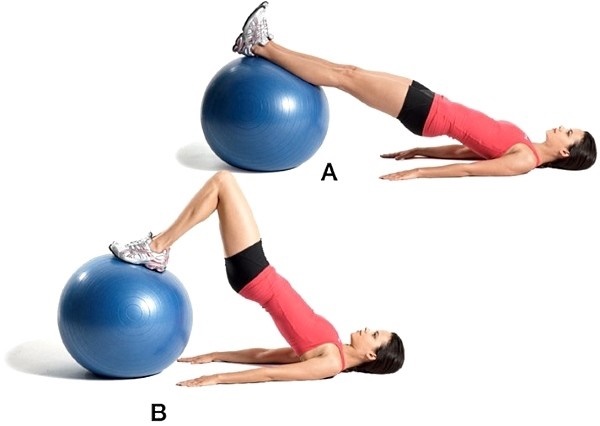
- Place your shoulders and upper back on the fitball. Hands lower down or fix behind the head, look up. The legs must be bent at the knees, and the feet must be spread shoulder-width apart. An alternative execution technique involves placing the legs on the gymnastic ball and the upper body on the floor.
- On exhalation, the thighs must be torn from the support, while maintaining balance. At the top point, without reducing the distance between the support and the buttocks, pause for 7 seconds.
- Inhaling through the nose, return the buttocks to their original position. Repeat the exercise 12-16 more times, completing at least 3 approaches.
With weight
Additional weight can be used to make the exercise more difficult. If the athlete is engaged in the gym, any sports equipment is suitable as a weighting agent. If the lesson is held at home, then the necessary weight can be provided with the help of books or a bottle of water.
Execution technique:
- Lie on the floor with your back down. In the area of the hip bones, fix the additional weight. The legs should be bent at the knees, and the feet should not be shoulder-width apart.
- While holding the extra weight with your hands, lift your buttocks off the floor, then pause at the highest point above the supporting surface.
- When the muscles in the buttocks and thighs begin to tremble from tension, the hips should be slowly lowered to their original position.
With dumbbells
The glute bridge with dumbbells can be performed by both experienced athletes and beginners. Depending on the selected mass of the sports equipment, you can adjust the load, focusing on your own feelings and the overall goal of the training program.
It is recommended for beginner athletes to use dumbbells as an additional load, weighing up to 5-7 kg; the number of approaches and repetitions - 3 to 10. Experienced athletes will be able to work out the muscles of the lower body by using dumbbells weighing 10-12 kg; the number of approaches and reps - 4 to 15.
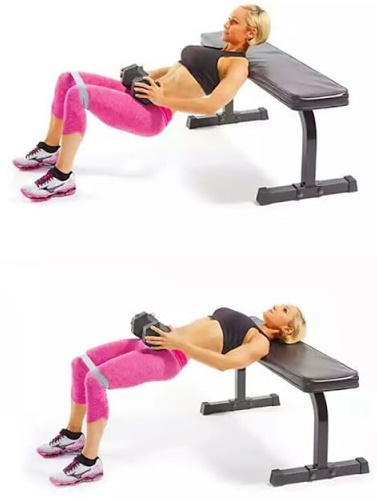
- Lie on the floor with your back down. Using your hands, fix a dumbbell of the required mass on the lower abdomen in the area of the hip bones. The back must be pressed against the support, the neck must be extended, and the gaze must be directed to the ceiling. The legs need to be bent at the knees, and the feet should be placed at a distance of 20-30 cm from each other.
- Exhaling through the mouth, the hips must be raised, fixing them at a maximum distance from the floor for 3-5 seconds.
- After the specified time, the buttocks must be slowly returned to their original position.
With pancake
The Pancake Glute Bridge is an alternate dumbbell exercise.
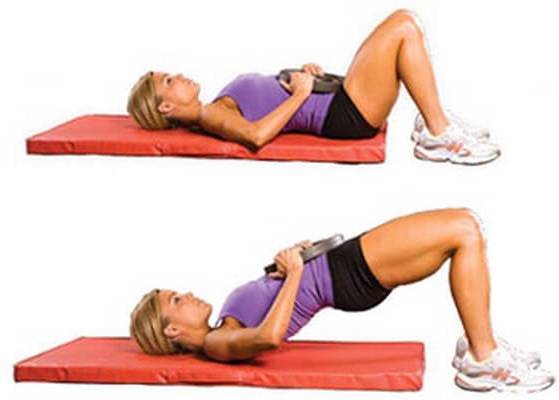
- Lie on the floor with your back down. Holding with your hands, place a metal pancake on the lower abdomen between the hip bones. The back should be pressed tightly to the floor, and the gaze should be directed to the ceiling. The legs must be bent at the knees, while placing the feet at shoulder distance.
- With an exhalation, tear the buttocks off the floor and bring them to the extremely high point. Maintain tension in the muscles of the buttocks and back of the legs for 3-5 seconds, without changing the position of the hips.
- After 3-5 seconds, the buttocks must be slowly lowered to their original position, overcoming the pressure of the sports equipment.
The exercise should be performed 10-15 times for 3-4 approaches within one workout. The mass of the pancake must be selected taking into account the physical fitness of the athlete, her contraindications, as well as the goal.
Off the bench
The glute bridge from the bench can be done in two ways. Fitness trainers recommend alternating exercise options to maximize training performance.
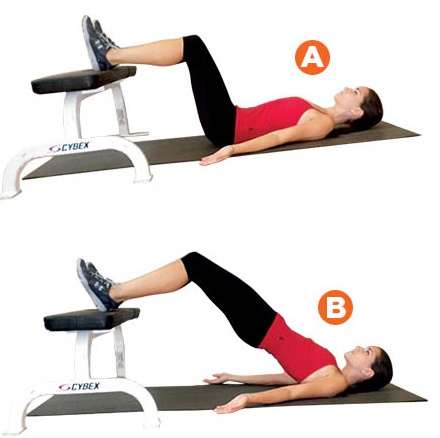
- Lie on your back with your shoulders and upper back on a horizontal bench. An alternative execution technique involves the location of the athlete on the floor with her legs bent on the bench. Hands should be left along the body, look up.
- With an exhalation, lift the hips as high as possible from the floor. Having reached the maximum tension, the buttocks should be fixed for 3-5 seconds.
- After the specified time, the buttocks must be returned to their original position, without touching the support itself. Without pausing, perform at least 10 reps and 4 sets.
During the implementation of the gluteal bridge, the athlete's breathing should be deep and rhythmic. Otherwise, its endurance will decrease due to the insufficient amount of oxygen supplied to the body.
In the leg curl machine
You can use a leg curl machine to increase the difficulty of the gluteal bridge. In this case, the exercise should be performed for 3-4 sets of 15 repetitions.
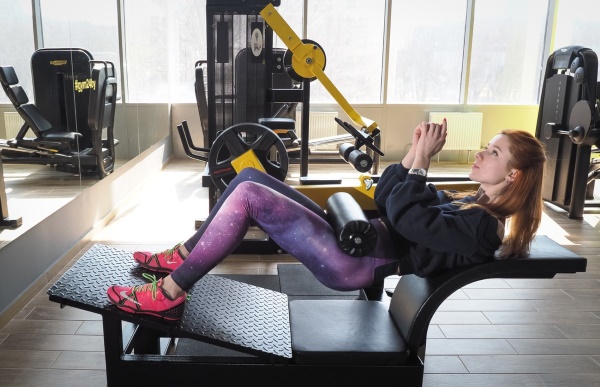
- Set the required load in the leg curl machine.
- Position yourself in the simulator so that your shoulders and upper back lie on the support bench, and a soft roller lies in the lower body. The roller should be fixed on the hip bones, and the hands should be placed on the stomach. The legs must be bent at the knees, making sure that in the initial position the buttocks do not touch the floor.
- With an exhalation, raise the buttocks, overcoming the resistance of the roller. Having reached the highest point, pause for at least 5 seconds, then return to the starting position with a deep breath.
With bar and bar
For athletes of an advanced level of physical fitness who regularly go in for sports for at least 6-7 months. in a row, it is recommended to perform a glute bridge with additional weight. As a secondary load, you can use an empty bar or a bar with pancakes.
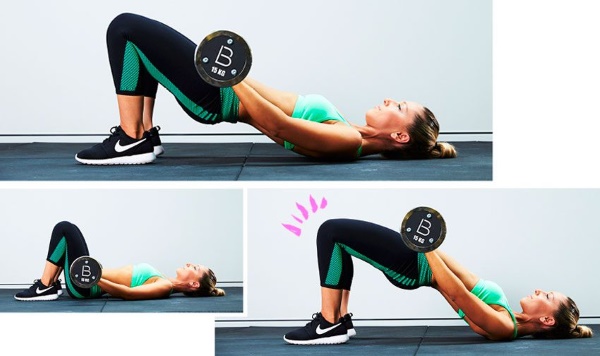
The technique for performing a complicated exercise looks like this:
- Lie on the floor with your back down. The back should be pressed to the floor, and a bar or bar with pancakes should be placed on the hip region. It is necessary to fix the weight with your hands, making sure that it does not fall or shift to the side.
- Exhaling through the mouth, the thighs need to be torn off the support surface, overcoming muscle resistance. At the point of maximum distance from the floor, the buttocks must be fixed for 3-4 seconds, and then slowly returned to their original position.
- Repeat the exercise at least 10 times. The optimal number of approaches is 3 (at the beginning of the training complex) or 2 (at the end or middle of the lesson).
In the Smith machine
The glute bridge can also be performed on the Smith machine. The optimal number of repetitions in this case will be 13-17, and approaches - 3-4, depending on the physical fitness of the athlete.
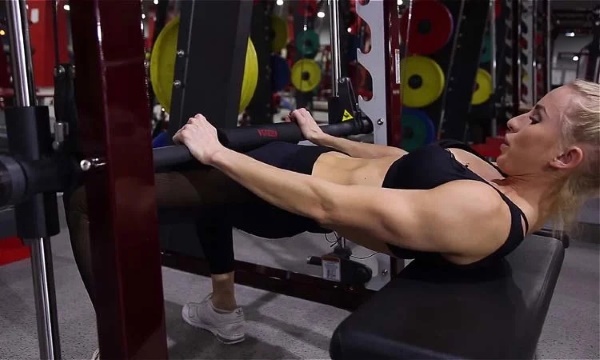
- Set the required load in the simulator. Place a horizontal bench at a distance of 10 cm from the simulator.
- Position yourself in the structure so that your shoulders and upper back lie on a horizontal bench, and the movable bar of the Smith simulator is fixed on your bent legs (in the area of the hip bones). Hands should hold the weighting agent throughout the entire exercise.
- With an exhalation, raise the buttocks to the maximum. Without pauses in the top position, smoothly return them to their original position, resisting the pressure of the bar.
Errors and helpful tips
In order for the regular implementation of the gluteal bridge to be as effective as possible, it is recommended to organize the training process in accordance with the advice of fitness instructors.
Recommendations:
- control the rhythm of breathing (on each effort there should be exhalation, and on muscle relaxation - inhalation);
- before doing the main exercises, warm up, and at the end of the workout - cool down (the duration of the preparatory complex should be at least 5 minutes, and the cool down in its duration should be 3-5 minutes, maximum);
- if the gluteal bridge is performed with weights, their mass should be increased gradually, allowing the muscles to adapt to a given level of load. Otherwise, the athlete runs the risk of injury or stretching (during the first lesson, the weight of the weighting agent, regardless of its type, should be no more than 5 kg);
- it is necessary to select additional weight so that the athlete can perform at least 10 repetitions with it within 1 approach.
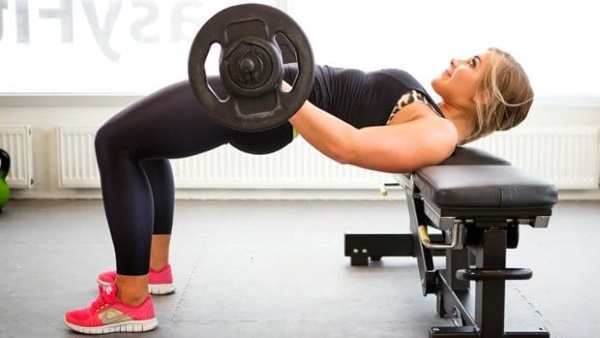
Even when performing the gluteal bridge, an exercise that is simple at first glance, it is necessary to follow the generally accepted algorithm in order to avoid injury and achieve maximum effectiveness from the training.
Video lesson "Glute Bridge"
Fitness Lessons: Glute Bridge:

